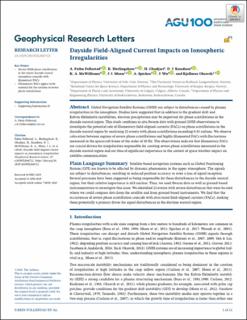| dc.contributor.author | Follestad, Anna Kristine Fæhn | |
| dc.contributor.author | Herlingshaw, Katie | |
| dc.contributor.author | Ghadjari, Hossein | |
| dc.contributor.author | Knudsen, David J. | |
| dc.contributor.author | McWilliams, Kathryn A. | |
| dc.contributor.author | Moen, Jøran Idar | |
| dc.contributor.author | Spicher, Andres | |
| dc.contributor.author | Wu, Jingjing | |
| dc.contributor.author | Oksavik, Kjellmar | |
| dc.date.accessioned | 2021-04-29T10:23:09Z | |
| dc.date.available | 2021-04-29T10:23:09Z | |
| dc.date.created | 2020-07-22T15:07:20Z | |
| dc.date.issued | 2020 | |
| dc.Published | Geophysical Research Letters. 2020, 47 (11), . | |
| dc.identifier.issn | 0094-8276 | |
| dc.identifier.uri | https://hdl.handle.net/11250/2740337 | |
| dc.description.abstract | Global Navigation Satellite Systems (GNSS) are subject to disturbances caused by plasma irregularities in the ionosphere. Studies have suggested that in addition to the gradient drift and Kelvin‐Helmholtz instabilities, electron precipitation may be important for phase scintillations in the dayside auroral region. This study combines in situ Swarm data with ground GNSS observations to investigate the potential role of filamentary field‐aligned currents (FACs) on phase scintillations in the dayside auroral region by analyzing 22 events with phase scintillations exceeding 0.45 radians. We observe colocation between regions of severe phase scintillations and highly filamented FACs with fluctuations measured in the spacecraft frame of the order of 20 Hz. The observations indicate that filamentary FACs are crucial drivers for irregularities responsible for creating severe phase scintillations measured in the dayside auroral region and are thus of significant importance in the context of space weather impact on satellite communication. | en_US |
| dc.language.iso | eng | en_US |
| dc.publisher | Wiley | en_US |
| dc.rights | Attribution-NonCommercial-NoDerivatives 4.0 Internasjonal | * |
| dc.rights.uri | http://creativecommons.org/licenses/by-nc-nd/4.0/deed.no | * |
| dc.title | Dayside Field-Aligned Current Impacts on Ionospheric Irregularities | en_US |
| dc.type | Journal article | en_US |
| dc.type | Peer reviewed | en_US |
| dc.description.version | publishedVersion | en_US |
| dc.rights.holder | Copyright 2020. The Authors. | en_US |
| dc.source.articlenumber | e2019GL086722 | en_US |
| cristin.ispublished | true | |
| cristin.fulltext | original | |
| cristin.qualitycode | 2 | |
| dc.identifier.doi | 10.1029/2019GL086722 | |
| dc.identifier.cristin | 1820207 | |
| dc.source.journal | Geophysical Research Letters | en_US |
| dc.source.40 | 47 | |
| dc.source.14 | 11 | |
| dc.relation.project | Norges forskningsråd: 275653 | en_US |
| dc.identifier.citation | Geophysical Research Letters. 2020, 47 (11), e2019GL086722. | en_US |
| dc.source.volume | 47 | en_US |
| dc.source.issue | 11 | en_US |

